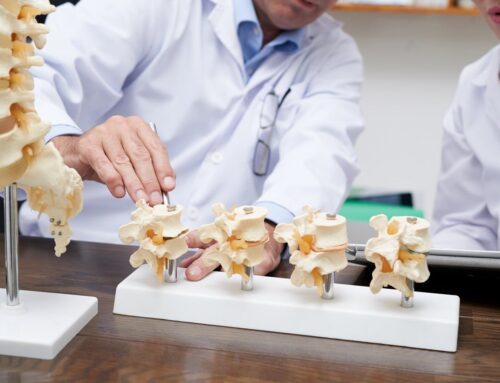Osteoporosis is a disease that weakens bones. As we get older, this condition reduces bone strength. Often it goes unnoticed for years. There are no symptoms until a bone breaks. And the link between osteoporosis and spinal fractures are not rare, especially in the elderly.
Fractures in the spine are common with osteoporosis. These fractures are known as vertebral compression fractures. In fact, spinal fractures very common when linked to osteoporosis. There can also be additional causes for vertebral fractures. And if a disease is a cause, a fracture is often the first sign. Let’s start off by going over the anatomy of the spine.
The spine consists of 24 bones called vertebrae, and these bones are stacked on top of each other. And a canal runs through these bones to protect the spinal cord. The spinal cord contains nerves that carry messages. This is how your brain communicates with your body. The nerve roots branch out through the vertebrae. Also, you have discs between each vertebra. These flexible intervertebral discs are padding. They absorb shock and cushion the bones.
Causes & Symptoms of an Osteoporosis Fracture
The bones naturally weaken as the body ages. Osteoporosis is natural as people get older. As the spinal vertebrae weaken, they become flat and narrow. A shorter stature and rounded back occur as a result. In severe cases, a “hump” can appear. Once weakened, these bones are at risk for fracture. When too much pressure is placed on weakened vertebrae, a break often occurs. Falling is the most common cause of these fractures. However, coughing, twisting, and sneezing can also cause a break.
The most common symptom of osteoporosis and spinal fractures is back pain, localized around the break. Typically vertebral fractures occur along the hip or waist. However, they can also happen slightly above or below this line. The pain will get worse with movement. Resting and lying down can sometimes bring relief. In rare cases, the pain radiates to other parts of the body. If this does happen, it will be to the legs or abdomen.
Treatment Options for Osteoporosis and Spinal Fractures
Spinal Fractures are treated non-surgically or surgically.
Non-surgical treatment involves rest and pain medications. Most fractures get better within a few months. Wearing a brace will reduce movement. and with rest, fractures can begin to heal on their own. However, if osteoporosis of the spine is suspected, additional options are available. Treatment to address bone density loss will also be prescribed.
Severe pain may require surgery. If other treatment options are not helping, surgery is considered. And procedures today are now less invasive. In fact, a vertebral augmentation is now a top option. However, there are two types of augmentations, such as:
Kyphoplasty: To reach the fractured vertebra an x-ray and need are required. A balloon tamp is next inserted and inflated within this area. Therefore, restoring the natural shape of the bone. The balloon tamp is then removed. And a cavity filled with bone cement will be placed to provide strength for the bone. You may be under general or local anesthesia for this procedure.
Vertebroplasty: This procedure is similar. But, there is no balloon tamp this time. The bone cement is injected into the spine by the affected vertebra. You will also be under anesthesia for this.
The procedure used will depend on your symptoms. Your doctor will need to evaluate your osteoporosis and spinal fracture type you have. After surgery, however, most people return to daily activities as soon as possible. Call us at 888-409-8006. Our spine specialists are here to help!







Leave A Comment